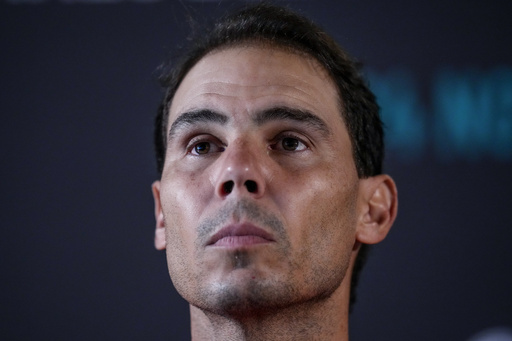
MALAGA, Spain — Rafael Nadal concluded his illustrious tennis journey on Tuesday, stepping away from the sport after Spain’s defeat against the Netherlands in the quarterfinals of the Davis Cup Final 8.
At the age of 38, Nadal has spent over two decades on the professional circuit and amassed an impressive collection of achievements, including 22 Grand Slam titles—14 of which were won at his beloved French Open—and a total of 92 ATP singles titles. He even reached the No. 1 position in the ATP rankings and maintained an unparalleled streak of being in the top 10 for nearly 18 years, despite having limited appearances in recent seasons due to various injuries.
Nadal will forever hold a significant place in tennis history alongside fellow legends Roger Federer and Novak Djokovic, collectively known as the Big Three.
A retrospective view of Nadal’s remarkable career reveals a series of highs and lows, as well as fierce rivalries and challenges from injuries:
In 2024, Nadal made one last attempt to compete at the French Open, but after missing three of the four Grand Slam tournaments that year, he finished with a modest singles record of 12 wins and 8 losses. Unfortunately, he faced a tough draw and lost in the first round to Alexander Zverev, who would ultimately be the tournament’s runner-up. At the Paris Olympics, held at Roland Garros, Nadal was also eliminated by Djokovic in the singles second round, and he did not proceed beyond the doubles quarterfinals with Carlos Alcaraz. On October 10, he declared that his final match in professional tennis would be at the Davis Cup, representing Spain in Malaga, where he ultimately fell to Botic van de Zandschulp 6-4, 6-4.
In 2023, Nadal faced adversity with a left hip flexor injury, which led to an early exit in the second round of the Australian Open against Mackie McDonald—his earliest Grand Slam defeat in seven years. This setback required surgery in June and kept him off the court for the remainder of the year.
During 2022, Nadal enjoyed a resurgence by winning his 21st and 22nd Grand Slam titles. He initially moved ahead of Federer for sole possession of the most Grand Slam singles titles, capturing his 21st at the Australian Open after a thrilling comeback against Daniil Medvedev. His 22nd title came at the French Open, where he triumphed over Casper Ruud amid struggles with debilitating foot pain. He withdrew from the Wimbledon semifinals due to a torn abdominal muscle and bowed out in the fourth round at the U.S. Open, losing to Frances Tiafoe.
In 2021, Nadal encountered a marked decline, losing a two-set lead against Stefanos Tsitsipas in the Australian Open quarterfinals, followed by a semifinal loss to Djokovic at the French Open. Persistent chronic pain in his left foot severely limited his participation for the remainder of the year, forcing Nadal to play just two additional matches.
The year 2020 saw Nadal tie Federer in the race for Grand Slam titles, securing his 20th trophy at the French Open by overcoming Djokovic in the final and achieving his fifth title there without dropping a set. This season also marked his 16th consecutive year of claiming multiple titles.
In 2019, Nadal added another French Open title (his 12th), along with a fourth U.S. Open title, marking his return to the No. 1 ranking at 33 years old. Throughout the year, he faced injury challenges, leading to a final match loss against Djokovic in the Australian Open final and a semifinal defeat to Federer at Wimbledon.
Nadal’s journey continued in 2018 with yet another French Open victory, increasing his total championships there to 11, but he struggled through various injuries during other tournaments.
In 2017, he claimed two major titles, achieving his 10th French Open triumph with a dominant performance before claiming his third U.S. Open title and finishing the year at No. 1 for a fourth time.
The struggles intensified in 2016, as Nadal failed to reach any Grand Slam quarterfinals for the first time since 2004, beset by a wrist injury.
Nadal’s decade-long streak of winning at least one Grand Slam title ended in 2015, with quarterfinal exits at all four majors, including a loss to Djokovic in the French Open quarterfinals.
In 2014, his success at the French Open culminated in tying Pete Sampras with 14 Slam titles.
The 2013 season marked a turn in form, returning to prominence with 10 titles, including two Grand Slams, after overcoming health issues.
In 2012, he secured a seventh French Open title while grappling with injury, leading to an early exit at Wimbledon.
His comeback in 2011 showcased his ability, tying Bjorn Borg’s record at the French Open but ultimately losing several finals to Djokovic throughout the season.
The year 2010 rekindled Nadal’s dominance at the French Open and led to a Wimbledon triumph, completing his career Grand Slam.
In 2009, Nadal experienced a stunning loss at the French Open but secured his first Australian Open title, defeating Federer.
The year 2008 was memorable as Nadal won both the French Open and Wimbledon finals and earned a gold medal at the Beijing Olympics, concluding the season ranked No. 1.
In 2007, he attained yet another French Open title but saw his clay court winning streak broken by Federer.
The year 2006 solidified Nadal’s status as he won a second French Open title but fell short at Wimbledon again.
In 2005, Nadal burst onto the scene, winning the French Open in his debut and moving into the top 10 of ATP rankings.
Finally, in 2004, he marked his first significant achievements by helping Spain win the Davis Cup and defeating Federer’s top ranking.
In his debut season in 2002, a 15-year-old Nadal garnered attention with his early performance, setting the stage for a storied career that captured the hearts of fans worldwide.
